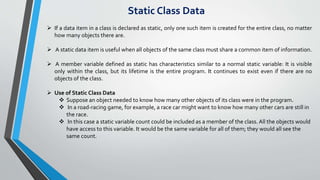
Static Class Data Members in C
- 1. Static Class Data If a data item in a class is declared as static, only one such item is created for the entire class, no matter how many objects there are. A static data item is useful when all objects of the same class must share a common item of information. A member variable defined as static has characteristics similar to a normal static variable: It is visible only within the class, but its lifetime is the entire program. It continues to exist even if there are no objects of the class. Use of Static Class Data Suppose an object needed to know how many other objects of its class were in the program. In a road-racing game, for example, a race car might want to know how many other cars are still in the race. In this case a static variable count could be included as a member of the class.All the objects would have access to this variable. It would be the same variable for all of them; they would all see the same count.
- 2. Program Example #include <iostream> using namespace std; //////////////////////////////////////////////////////////////// class foo { private: static int count; //only one data item for all objects //note: “declaration” only! public: foo() //increments count when object created { count++; } int getcount() //returns count { return count; } }; //-------------------------------------------------------------- int foo::count = 0; //*definition* of count The variable is defined outside the class because it will not be part of any object. It is created only once in the memory and is shared among all the objects of the class int main() { foo f1, f2, f3; //create three objects cout << "count is " << f1.getcount() << endl; //each object cout << "count is " << f2.getcount() << endl; //sees the cout << "count is " << f3.getcount() << endl; //same value return 0; }
- 3. Working The class foo in this example has one data item, count, which is type static int. The constructor for this class causes count to be incremented. In main() we define three objects of class foo. Since the constructor is called three times, count is incremented three times. Another member function, getcount(), returns the value in count.We call this function from all three objects, and as we expected each prints the same value. Here’s the output: count is 3 ←static data count is 3 count is 3 If we had used an ordinary automatic variable as opposed to a static variable for count, each constructor would have incremented its own private copy of count once, and the output would have been count is 1 ← automatic data count is 1 count is 1
- 4. const Member Functions A const member function guarantees that it will never modify any of its class’s member data. A function is made into a constant function by placing the keyword const after the declarator but before the function body. If there is a separate function declaration, const must be used in both declaration and definition. //demonstrates const member functions #include<iostream> using namespace std; class aClass { private: int alpha; public: void nonFunc() //non-const member function { alpha = 99; } //OK void conFunc()const //const member function { alpha = 100; //ERROR: can’t modify a member cout<<alpha; } }; int main() { aClass f; f.conFunc(); return 0; }
- 5. Static Functions To access a private or protected static class member when no objects of the class exist, provide a public static member function and call the function by prefixing its name with the class name and scope resolution operator. Example #include <iostream> using namespace std; class foo { private: static int count; //only one data item for all objects //note: “declaration” only! public: static void show() { cout<<count; } }; //-------------------------------------------------------------- int foo::count = 10; //*definition* of count int main() { foo::show(); return 0; } Output 10